Sous Vide Lemon Salmon with Duo of Hokkaido
A good friend and foodie gave me a wonderful birthday present: the new Anova wifi sous vide cooker. Now back home from holidays in beautiful South Africa, I immediately started cooking with my new baby. Like all fish, it is very easy to overcook salmon. That’s why sous vide is such an excellent method for preparing fish. We never ever had better salmon. This flavor-packed fish with its hearty yet delicate taste is so buttery soft and moist inside, yet crisp on the outside. A real taste explosion in your mouth. Salmon works well with many different dishes. Here I served it with two different kinds of Hokkaido on the side: a creamy and slightly spicy Hokkaido puree and a nutty flavorful Hokkaido quinoa.
You need the following ingredients: (serves about 4-6)
For the salmon:
- 500 g / 1.1 lbs fresh salmon fillet
- 1 organic lemon
- 2 tbsp olive oil
- salt and pepper (to taste)
For the Hokkaido Quinoa and Puree:
- 1 Hokkaido pumpkin
- 135 g / 3/4 cup quinoa
- 2 – 3 cm / ~1 inch ginger
- 120 ml / 1/2 cup coconut cream
- 1 tbsp olive oil
- pinch cinnamon
- 1/2 tsp curcuma
- 1/2 tsp cumin
- 1/2 tsp chili powder
- 1/2 tsp paprika powder
- salt and pepper (to taste)
To make the sous vide lemon salmon:
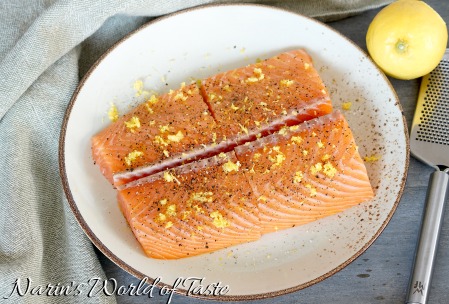
Dry the salmon fillet with a paper towel and cut it into 4-6 pieces, depending on how many people and different courses you’re going to serve. Season the salmon pieces with the lemon zest, olive oil, salt, and pepper.
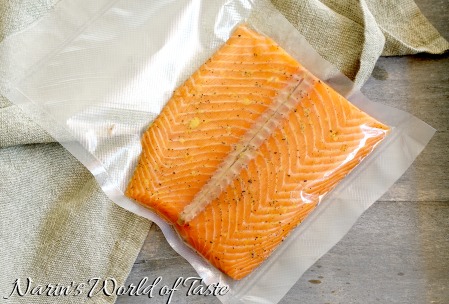
Set your sous vide cooker to 46.1 °C / 115 °F. If you have a vacuum sealer, vacuum seal the salmon fillets. If you don’t have a vacuum sealer, you can also use another method and seal the salmon fillets in a zip-lock bag. This method is called “the water displacement method”. Add your salmon to a large zip-lock bag and close it, but don’t close it all the way. Then slowly lower the bag into the water bath and let the pressure of the water displace the remaining air around the salmon fillets. The open end of the bag has to stay above water level. When the remaining air is gone, hang the end of the bag over the edge of the sous vide bath. Use a paperclip or lid to keep it in place.
Sous vide the salmon fillets for about 45 minutes.
To make the Hokkaido quinoa and puree:
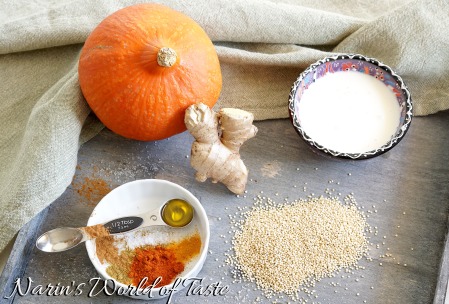
Preheat the oven to 180 °C / 360 °F.
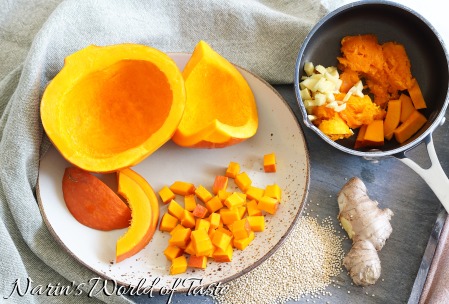
Cut the edges off the Hokkaido pumpkin and then cut it in half. Scoop out the flesh and seeds of the Hokkaido. You can do this best by using a tablespoon. Wash the Hokkaido and cut each half into two quarters. Slice them into about 1 cm / 0.4 inch thick slices. Try to cut the slices into similar-shaped cubes. Take a medium-sized pot for the puree and add the edge pieces and any other cubes that have odd shapes. You should end up with about 2/3 of the Hokkaido cut into nice cubes and 1/3 for the puree. Peel the ginger (the most efficient way is to use a teaspoon instead of a knife), and then chop about 2 – 3 cm (about 1 inches) of its root and add it to the pot for the puree.
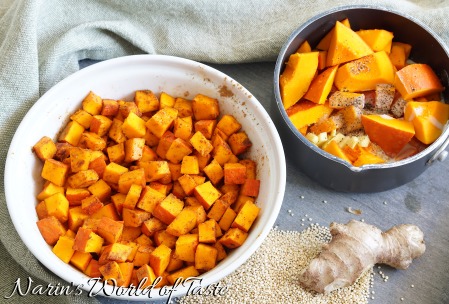
Pour the Hokkaido cubes into a casserole dish. Season with 1 tbsp olive oil, pinch of cinnamon, 1/2 tsp each of curcuma, cumin, chili powder, paprika powder, then add salt and pepper to taste. Bake it in the oven for about 25 – 30 minutes or until the Hokkaido starts browning. You can give them a stir half way though to bake them evenly. For the Hokkaido puree, add the coconut cream, salt, and pepper to the pot. Bring it to a boil, give it a good stir, and let it simmer with the lid closed on low heat until the Hokkaido is soft. To prepare the quinoa, pour the quinoa into a fine strainer and rinse it thoroughly with cold water. Add the quinoa to a medium-sized pot and add twice the amount of water (360 ml / 1.5 cups). Bring the quinoa to a boil and then reduce the heat to very low temperature. Cover the pot with a lid and let the quinoa simmer for about 15 minutes until all the water is gone and the quinoa popped – by this I mean the tiny spirals separating from the seeds.
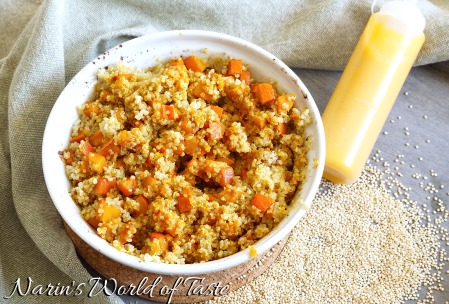
Blend the puree with a hand blender or high power blender until smooth. If you have a dispensing bottle, pour the puree into the bottle. This will help create nice and evenly shaped puree dots on your plates. If you don’t have such bottle, don’t worry, you can use a spoon or similar to create a nice plate arrangement. Mix the cooked quinoa and the baked Hokkaido cubes together thoroughly. Season to taste if needed.
Heat a grilling pan over high heat. Very carefully remove the salmon from the vacuum or zip-lock bag and fry it on the skin side (or where the skin used to be) for about 3-4 minutes until nicely brown and crisp.
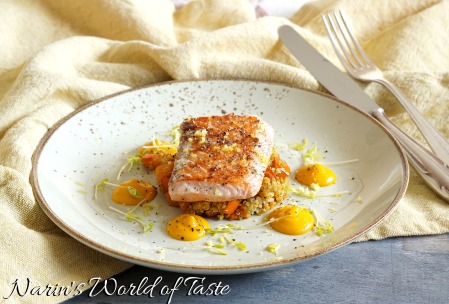
Meanwhile, you can start serving. A plate heater, if you have one, would come in very handy. That way the food stays warm for a longer time. Add the Hokkaido quinoa in the middle of the plate. If you have food forming rings, this is a great opportunity to use them. Else, use a normal table spoon and arrange nicely. Arrange the Hokkaido puree around it in evenly shaped dots, like in the picture above. Place one salmon fillet on top of the Hokkaido quinoa and sprinkle some lemon zest, olive oil, cress, salt, and pepper over the plate. Serve immediately.
Enjoy, Melanie…
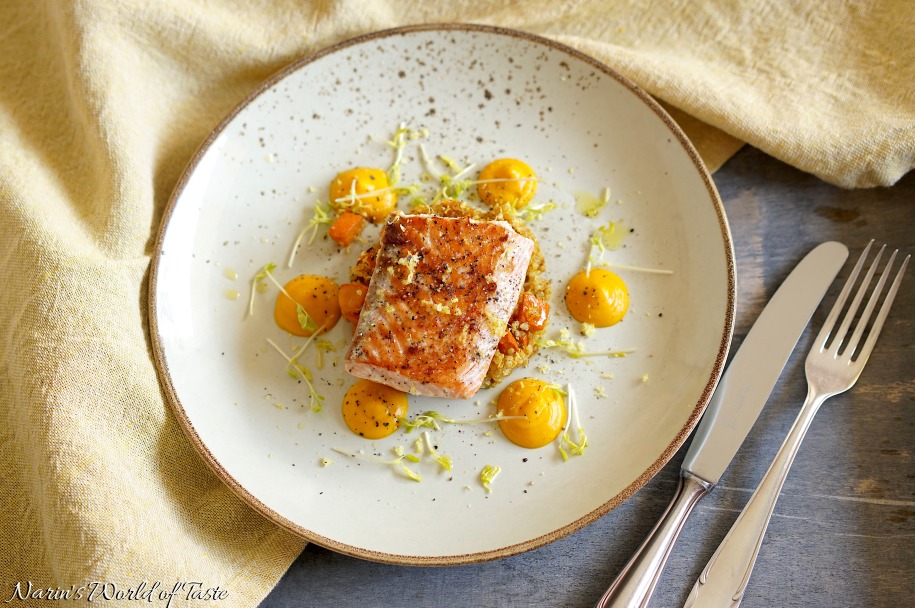
Categories: Main Dishes, World of Recipes
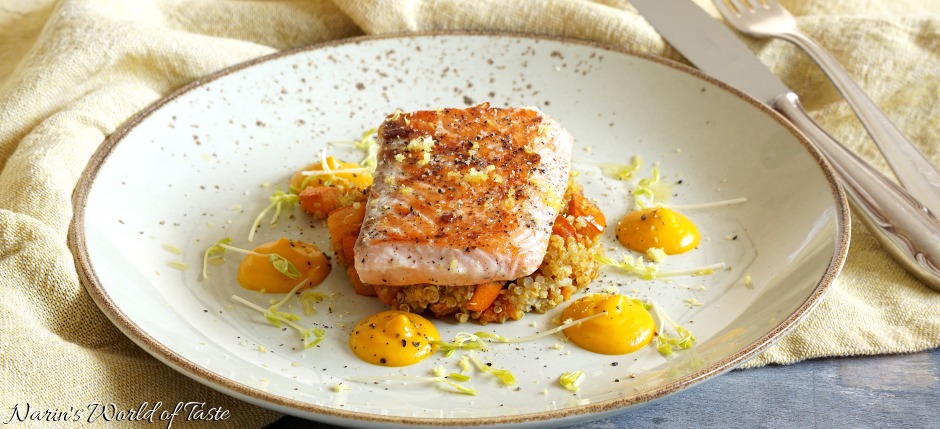








Leave a Comment